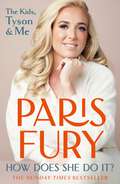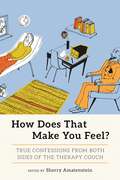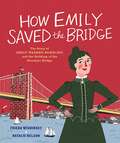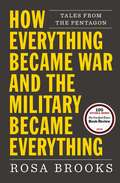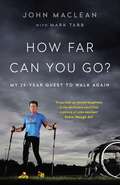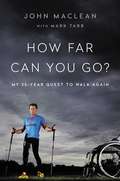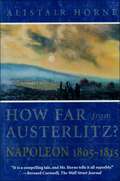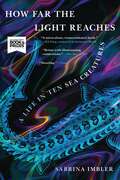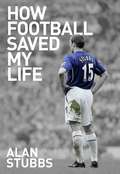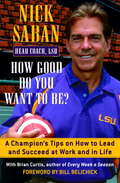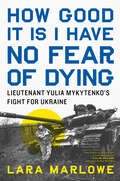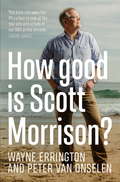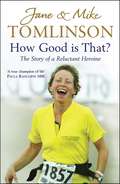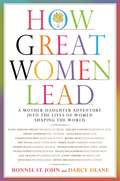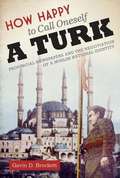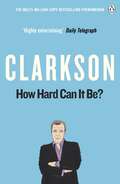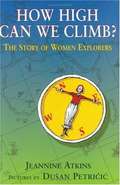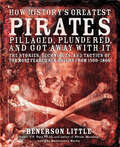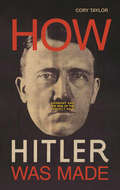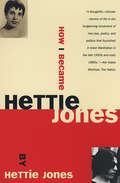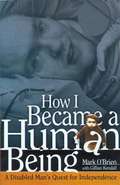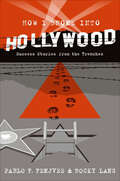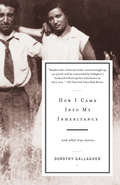- Table View
- List View
How Does She Do It?: The Kids, Tyson & Me
by Paris FuryAlongside the number-one 2023 Netflix series At Home with the Furys, bestselling author of Love and Fury Paris Fury reveals the answers to the question she's always asked. How does she manage life as a hands-on mother to seven children, as well as supporting World Heavyweight husband Tyson, while still looking amazing and finding time for herself?Paris Fury can pack a week into everyone else's day. Now she tells us how she does it.Looking after seven children, keeping house, looking amazing, being there for her World Heavyweight husband Tyson, and finding time for herself: this is just a shortlist of what Paris manages.A lot can go wrong, and often does, but Paris takes it all in her stride.She learned her great homemaking skills in her Gypsy childhood and here she shares all about daily life with the big Fury family and what works to keep life running - from shopping, mealtimes and big celebrations, to being ready for the unexpected, handling a crisis, and her tricks for keeping their home clean and uncluttered, as well as warm and welcoming.Balancing day-to-day parenting with Tyson alongside his boxing career, she is open about the stresses that go along with all the travel, fun and excitement.On top of all this, Paris manages to find time for herself, too - her incredible can-do, ready-for-anything attitude is a real inspiration to us all.
How Does That Make You Feel?: True Confessions from Both Sides of the Therapy Couch
by Sherry AmatensteinHow Does That Make You Feel? obliterates the boundaries between the shrink and the one being shrunk with unabashedly candid writers breaking confidentiality and telling all about their experiences in therapy. This revelatory, no-punches-pulled book brings to light both sides of the "relationship” between therapist and client-a bond that can feel pure and profound, even if it is, at times, illusory. Contributors include an array of essayists, authors, TV/film writers and therapists, including Patti Davis, Beverly Donofrio, Royal Young, Molly Peacock, Susan Shapiro, Charlie Rubin, Estelle Erasmus, and Dennis Palumbo. Full list of contributors: Sherry Amatenstein Laura Bogart Martha Crawford Patti Davis Megan Devine Beverly Donofrio Janice Eidus Estelle Erasmus Juli Fraga Nina Gaby Mindy Greenstein Jenine Holmes Diane Josefowicz Jean Kim Amy Klein Binnie Klein Anna March Allison McCarthy Kurt Nemes Dennis Palumbo Molly Peacock Pamela Rafalow Grossman Charlie Rubin Jonathan Schiff Barbara Schoichet Adam Sexton Susan Shapiro Beth Sloan Eve Tate Kate Walter Priscilla Warner Linda Yellin Royal Young Jessica Zucker
How Emily Saved the Bridge: The Story of Emily Warren Roebling and the Building of the Brooklyn Bridge
by Frieda WishinskyThe amazing story of Emily Warren Roebling, the woman who stepped in to oversee the construction of the Brooklyn Bridge, which was completed in 1883.Emily was not an engineer, but she was educated in math and science. She married Washington Roebling, the chief engineer of the famous bridge. When Washington became ill from decompression sickness, Emily stepped in, doing everything from keeping the books, to carrying messages for her husband, to monitoring the construction of the bridge. She was the first person to cross the Brooklyn Bridge when it opened.Emily, who went on to study law among many other accomplishments, is an inspiration to all, as demonstrated through Frieda Wishinsky’s informative and engaging text and Natalie Nelson’s distinctive collage illustrations. Speech bubbles revealing imagined dialogue add a playful note to this historical account, which includes fascinating facts about the Brooklyn Bridge and a further reading list.Key Text Featuresfurther readingspeech bubblesCorrelates to the Common Core State Standards in English Language Arts:CCSS.ELA-LITERACY.RL.2.1Ask and answer such questions as who, what, where, when, why, and how to demonstrate understanding of key details in a text.CCSS.ELA-LITERACY.RL.4.3Describe in depth a character, setting, or event in a story or drama, drawing on specific details in the text (e.g., a character's thoughts, words, or actions).
How Everything Became War and the Military Became Everything: Tales from the Pentagon
by Rosa BrooksThe first serious book to examine what happens when the ancient boundary between war and peace is erased.Once, war was a temporary state of affairs--a violent but brief interlude between times of peace. Today, America's wars are everywhere and forever: our enemies change constantly and rarely wear uniforms, and virtually anything can become a weapon. As war expands, so does the role of the US military. Today, military personnel don't just "kill people and break stuff." Instead, they analyze computer code, train Afghan judges, build Ebola isolation wards, eavesdrop on electronic communications, develop soap operas, and patrol for pirates. You name it, the military does it. Rosa Brooks traces this seismic shift in how America wages war from an unconventional perspective--that of a former top Pentagon official who is the daughter of two anti-war protesters and a human rights activist married to an Army Green Beret. Her experiences lead her to an urgent warning: When the boundaries around war disappear, we risk destroying America's founding values and the laws and institutions we've built--and undermining the international rules and organizations that keep our world from sliding towards chaos. If Russia and China have recently grown bolder in their foreign adventures, it's no accident; US precedents have paved the way for the increasingly unconstrained use of military power by states around the globe. Meanwhile, we continue to pile new tasks onto the military, making it increasingly ill-prepared for the threats America will face in the years to come. By turns a memoir, a work of journalism, a scholarly exploration into history, anthropology and law, and a rallying cry, How Everything Became War and the Military Became Everything transforms the familiar into the alien, showing us that the culture we inhabit is reshaping us in ways we may suspect, but don't really understand. It's the kind of book that will leave you moved, astonished, and profoundly disturbed, for the world around us is quietly changing beyond recognition--and time is running out to make things right.
How Far Can You Go
by Mark Tabb John Maclean'If you look up mental toughness in the dictionary you'll find a picture of John Maclean' Steve Waugh AO Walking on the beach and holding hands with a loved one is a dream taken for granted by most. But when aspiring athlete John Maclean was struck down by a truck while training for a triathlon at the age of 22, this dream became impossible. John survived, but was left paraplegic - catastrophic for a life so full of promise. He insisted that he'd walk again, but it became clear John would need to shift his focus, and take his beloved father's words to heart: 'How far can you go?' With fierce tenacity, determination, and the love of family and friends, John became one of the most accomplished wheelchair athletes in the world, the first wheelchair athlete to complete the Ironman World Championships and the first paraplegic to swim the English Channel. He also competed in the Sydney Olympics wheelchair demonstration race and in two Paralympic Games in two different disciplines, winning a silver medal for rowing in Beijing. But John still longed to walk, hand in hand, on the beach with his wife. It wasn't until he discovered a radical therapy that John was able to reach his full potential by retraining his mind and body to unlock new neural responses . . . and stand, walk, and fulfill his dream. How Far Can You Go? is John Maclean's amazing story, and his quest to walk again after 25 years in a wheelchair.
How Far Can You Go?: My 25-Year Quest to Walk Again
by Mark Tabb John MacleanAn inspirational memoir by a man who became an elite wheelchair athlete after suffering a catastrophic spinal injury and who finally walked again 25 years after his accident. After two years of intense physical therapy following his crippling accident, John Maclean set a new course for himself when his father encouraged him to embrace his new reality and asked: "How far can you go?" Inspired, Maclean became the first paraplegic to complete the Ironman World Championship and swim the English Channel before going on to win a silver medal for rowing at the 2008 Paralympic Games--yet these achievements did not come easy or on his first try. But with fierce tenacity, determination, and the love of family and friends Maclean was able to see each dream realized. Yet he longed for one more victory: to walk on the beach with his family, holding his wife's hand. Through a radical therapy, he retrained his mind and challenged conventional thinking to walk again after 25 years in a wheelchair. HOW FAR CAN YOU GO? is his amazing story.
How Far from Austerlitz?: Napoleon 1805–1815
by Alistair HorneA London Sunday Times Book of the YearA Daily Telegraph Book of the YearAlistair Horne explores the theme of military success and failure in How Far From Austerlitz? chronicling Napoleon's rise and fall, drawing parallels with other great leaders of the modern era. The Battle of Austerlitz was Napoleon's greatest victory, the culmination of one of the greatest military campaigns of all time. It was also the last battle the "Father of Modern Warfare" would leave in absolute triumph, for, though he did not know it, Austerlitz marked the beginning of Napoleon's downfall. His triumph was too complete and his conquest too brutal to last. Like Hitler, he came to believe he was invincible, that no force could halt his bloody march across Europe. Like Hitler, he paid dearly for his hubris, climaxing in bitter defeat at Waterloo in 1815. In a matter of years, he had fallen from grace.
How Far the Light Reaches: A Life in Ten Sea Creatures
by Sabrina ImblerA fascinating tour of creatures from the surface to the deepest ocean floor: this "miraculous, transcendental book" invites us to envision wilder, grander, and more abundant possibilities for the way we live (Ed Yong, author of An Immense World). A queer, mixed race writer working in a largely white, male field, science and conservation journalist Sabrina Imbler has always been drawn to the mystery of life in the sea, and particularly to creatures living in hostile or remote environments. Each essay in their debut collection profiles one such creature, including: ·the mother octopus who starves herself while watching over her eggs, ·the Chinese sturgeon whose migration route has been decimated by pollution and dams, ·the bizarre, predatory Bobbitt worm (named after Lorena), ·the common goldfish that flourishes in the wild, ·and more. Imbler discovers that some of the most radical models of family, community, and care can be found in the sea, from gelatinous chains that are both individual organisms and colonies of clones to deep-sea crabs that have no need for the sun, nourished instead by the chemicals and heat throbbing from the core of the Earth. Exploring themes of adaptation, survival, sexuality, and care, and weaving the wonders of marine biology with stories of their own family, relationships, and coming of age, How Far the Light Reaches is a shimmering, otherworldly debut that attunes us to new visions of our world and its miracles. WINNER OF THE LOS ANGELES TIMES BOOK PRIZE in SCIENCE & TECHNOLOGY Finalist for the Lambda Literary Award One of TIME&’s 10 Best Nonfiction Books of the Year • A PEOPLE Best New Book • A Barnes & Noble and SHELF AWARENESS Best Book of 2022 • An Indie Next Pick • One of Winter&’s Most Eagerly Anticipated Books: VANITY FAIR, VULTURE, BOOKRIOT
How Far to the Promised Land: One Black Family's Story of Hope and Survival in the American South
by Esau McCaulleyFrom the New York Times contributing opinion writer and award-winning author of Reading While Black, a riveting intergenerational account of his family&’s search for home and hope&“A riveting book that invites you into the personal journey of one of the finest writers alive today.&”—Beth Moore, New York Times bestselling author of All My Knotted-Up Life For much of his life, Esau McCaulley was taught to see himself as an exception: someone who, through hard work, faith, and determination, overcame childhood poverty, anti-Black racism, and an absent father to earn a job as a university professor and a life in the middle class. But that narrative was called into question one night, when McCaulley answered the phone and learned that his father—whose absence defined his upbringing—died in a car crash. McCaulley was being asked to deliver his father&’s eulogy, to make sense of his complicated legacy in a country that only accepts Black men on the condition that they are exceptional, hardworking, perfect. The resulting effort sent McCaulley back through his family history, seeking to understand the community that shaped him. In these pages, we meet his great-grandmother Sophia, a tenant farmer born with the gift of prophecy who scraped together a life in Jim Crow Alabama; his mother, Laurie, who raised four kids alone in an era when single Black mothers were demonized as &“welfare queens&”; and a cast of family, friends, and neighbors who won small victories in a world built to swallow Black lives. With profound honesty and compassion, he raises questions that implicate us all: What does each person&’s struggle to build a life teach us about what we owe each other? About what it means to be human? How Far to the Promised Land is a thrilling and tender epic about being Black in America. It&’s a book that questions our too-simple narratives about poverty and upward mobility; a book in which the people normally written out of the American Dream are given voice.
How Football Saved My Life
by Alan StubbsThe day had gone badly: Celtic had just lost to their Old Firm rivals Rangers in the 1999 Scottish Cup final, and now Alan Stubbs had to provide a sample for a random drugs test. Little did he know, but it would help save his life... The results of the test showed he had testicular cancer, and suddenly, at the age of 27 and at the peak of fitness, he realised that he had the biggest battle of his life in front of him. In this compelling and moving memoir, Stubbs recalls his despair at the time and explains how, with the support of family, friends and fans as well as terrific doctors, he pulled through to resume his career at the top. And what a career it was. First he helped Bolton Wanderers climb up two divisions to reach the Premier League in 1995. The following season, he moved to Celtic for a record fee, helping them to break the stranglehold on the league title held by Rangers. After recovering from cancer, he moved to Everton, his hometown club, where he would spend most of the rest of his playing career, lining up alongside (among others) an ageing Paul Gascoigne and an emerging Wayne Rooney. A knee injury forced him to retire in 2008, but he is now on the coaching staff at Everton. A player who has seen the game at all levels, he has also had to contend with the most shocking challenges in life, which makes his story an unmissable read.
How Good Do You Want to Be? A Champion's Tips on How to Lead and Succeed at Work and in Life: A Champion's Tips on How to Lead and Succeed at Work and in Life
by Brian Curtis Nick SabanHe guided LSU to its first football championship in forty-five years. He turned down countless offers from professional teams to stay with the job he loves. Now Nick Saban reveals the secrets that will help you lead and succeed at work and in life. Excellence doesn't happen overnight. It comes from hard work, consistency, the drive to be the best, and a passion for what you do. Few understand this better than Nick Saban, the hottest college football coach in the game. Now, in How Good Do You Want to Be?, Saban shares his winning philosophy for creating and inspiring success. In more than three decades as a player and coach, Saban has learned much about life and leadership, both on the field and off. Working alongside some of the game's legends, including Super Bowl winner Bill Belichick and coaching legend Jerry Glanville, he saw firsthand how great leaders encourage greatness in others. In this candid, insightful guide, he shares such acquired wisdom as *Organization, Organization, Organization. Create an environment where everybody knows his or her responsibilities--and each is responsible to the entire group. *Motivate to Dominate. Understand the psychology of teams and individuals, and use that knowledge to breed success. *No Other Way than Right. Practice ethics and values--and demand the same from your team. *Look in the Mirror. Maintain an understanding of who you are by knowing your strengths and your weaknesses. How Good Do You Want to Be? is more than the story of how Nick Saban motivates his staff and players to excel--it is also the memoir of one of America's most successful coaches. Filled with instructive anecdotes and illuminated by never-before-told stories of his life and career, this is a book that challenges and inspires us all to be our best.
How Good It Is I Have No Fear of Dying: Lieutenant Yulia Mykytenko's Fight for Ukraine
by Lara MarlowePublishing on the third anniversary of the war in Ukraine: The gripping, heartrending story, told in her own words, of a formidable 29-year-old woman serving as a commander on the front lines of the War in Ukraine — and an intimate, hair-raising look at modern warfare . . .Lieutenant Yulia Mykytenko, a commander in the Ukrainian army serving on the front line of battle, embodies her country's resistance to the Russian invasion. When her father self-immolated on Maidan Square in central Kyiv in an act of protest, she held a press conference to explain to journalists that he acted &“in sound mind.&” Later, in battle on the front line, she would learn via radio-phone that her husband had been killed nearby.In 2023, veteran war correspondent Lara Marlowe met Mykytenko while covering the war, and found her to be &“one of the most extraordinary people I have interviewed in 42 years of journalism.&” From their months of conversations, Marlowe stitched together Mykytenko&’s accounts into a riveting revelation of what modern warfare is really like.Told entirely in Mykytenko's first person voice, it is a story of cluster bombs and ballistic missiles. Mykytenko has most recently commanded a drone unit, and the scenes of launching drone attacks, and of being attacked by drones, are electrifying and harrowing. At the same time there are vestiges of WWII: trench warfare, no-man&’s lands seeded with mines, even chemical weapons.The result is an urgent story of a besieged nation, a vivid look at the changing face of warfare, and the stirring tale of an inspirational woman fighting for her country's survival.
How Good is Scott Morrison?
by Wayne Errington Peter van OnselenWithout fear or favour, How Good is Scott Morrison? examines the trials and tribulations of our 30th prime minister. Investigating Morrison's unlikely rise to the liberal leadership and his miracle electoral win, van Onselen and Errington put his leadership under the spotlight.Covering Morrison's disastrous management of the catastrophic bushfire season that was highlighted by the extraordinary statement, 'I don't hold the hose, mate,' and the decision to holiday while the country burned, How Good is Scott Morrison? shows his resolve and the redemption the government's response to the pandemic brought him.Right now, Scott Morrison seems unassailable and sure to win the next election, but what exactly is his vision for Australia? A pragmatist rather than an ideologue, he is a deeply Pentecostal religious man but he doesn't wear his faith as a badge of honour. So what does he really believe in?When the history of this period is written, Morrison will certainly be seen as an election winner but will he be viewed as having had the courage and vision to change Australia for the better, or the worse?
How Good is That?
by Jane Mike TomlinsonFollowing a seven-year battle with cancer, Jane Tomlinson died at the age of 43 in September 2007. Almost exactly one year earlier, on 1 September 2006, Jane finished a gruelling nine-week, 3,700-mile cycle ride from the west coast to the east coast of America. Her journey was hailed as one of the greatest endurance feats ever by a terminal cancer sufferer. How Good is That? takes the reader behind the scenes of this extraordinary last ride across terrain and in temperatures which were to prove almost untenable as Jane's illness worsened. She was defiant to the end. The book, already substantially written by Jane for her part before her death, has been completed by Mike to give an incredible and moving insight into his wife's final days as well as the achievements, emotional and physical, of a woman who inspired a nation.
How Great Women Lead: A Mother-Daughter Adventure into the Lives of Women Shaping the World
by Bonnie St. John Darcy DeaneIn boardrooms and lecture halls, on the field and at home, strong female leaders are making a statement around the globe. In HOW GREAT WOMEN LEAD Bonnie St. John and her teenage daughter, Darcy Deane, explore the qualities that motivate some of the world's most powerful women. Through engaging, out-of-the-spotlight interchanges, the authors discover commonly held values, behaviors, and attitudes, as well as the subtle, special skills inherent in female leaders.From the ethics of Dr. Condoleeza Rice to the fortitude of Hillary Rodham Clinton to the enthusiasm of Teach for America founder Wendy Kopp and the discipline of Geena Davis, each woman in this book shares the exciting story of her rise to the top and the unique qualities it took to get there.
How Green is My Mountain
by Ruth KlaasenFrom the windswept Canadian prairies to the University of Saskatchewan, from McGill University to the Philippines and Mt. Banahaw--the mountain that becomes her mountain for a very special reason... Ruth Klaasen weaves a story of joy and romance, boldness and humility, hardship and sickness, birth and death. More than a story, this account takes us into the life and lifestyle of a North American family who lived for Jesus Christ in an international community in a foreign country. Struggles with assimilating a new and very different culture, failures to communicate with servants and neighbors, questions of conflicting values, difficulties of explaining the gospel, the issue of what church to join--these blend together with problems we all face in realizing God's presence in our lives.
How Happy to Call Oneself a Turk
by Gavin D. BrockettThe modern nation-state of Turkey was established in 1923, but when and how did its citizens begin to identify themselves as Turks? Mustafa Kemal Ataturk, Turkey's founding president, is almost universally credited with creating a Turkish national identity through his revolutionary program to "secularize" the former heartland of the Ottoman Empire. Yet, despite Turkey's status as the lone secular state in the Muslim Middle East, religion remains a powerful force in Turkish society, and the country today is governed by a democratically elected political party with a distinctly religious (Islamist) orientation. In this history, Gavin D. Brockett takes a fresh look at the formation of Turkish national identity, focusing on the relationship between Islam and nationalism and the process through which a "religious national identity" emerged. Challenging the orthodoxy that Ataturk and the political elite imposed a sense of national identity from the top down, Brockett examines the social and political debates in provincial newspapers from around the country. He shows that the unprecedented expansion of print media in Turkey between 1945 and 1954, which followed the end of strict, single-party authoritarian government, created a forum in which ordinary people could inject popular religious identities into the new Turkish nationalism. Brockett makes a convincing case that it was this fruitful negotiation between secular nationalism and Islam--rather than the imposition of secularism alone--that created the modern Turkish national identity.
How Hard Can It Be?: The World According to Clarkson Volume 4 (The World According to Clarkson)
by Jeremy ClarksonHow Hard Can it Be? is the fourth hilarious volume in Jeremy Clarkson's The World According to Clarkson series.How hard can it be...To build a power station without upsetting the eco-mentalists? To seek world domination if you've been hit the ugly stick? For the Met Office to get yesterday's weather right?In volume four of The World According to Clarkson, Jeremy Clarkson pours scorn on the nonsensical, the dumb, the idiotic and the plain foolish in his continuing quest to discover where exactly we've all gone wrong.Along the way he ponders:• Whether conquering France might solve the immigration problem• What happened when you ignore proper warning labels • What would happen if we turned the internet offOften controversial, frequently scathing but always funnier than James May, Jeremy Clarkson shows us how we could so easily make the world a better place. Praise for Jeremy Clarkson:'Brilliant . . . laugh-out-loud' Daily Telegraph'Outrageously funny . . . will have you in stitches' Time OutNumber-one bestseller Jeremy Clarkson writes on cars, current affairs and anything else that annoys him in his sharp and funny collections. Born To Be Riled, Clarkson On Cars, Don't Stop Me Now, Driven To Distraction, Round the Bend, Motorworld, and I Know You Got Soul are also available as Penguin paperbacks; the Penguin App iClarkson: The Book of Cars can be downloaded on the App Store.Jeremy Clarkson because his writing career on the Rotherham Advertiser. Since then he has written for the Sun and the Sunday Times. Today he is the tallest person working in British television, and is the presenter of the hugely popular Top Gear.
How High Can We Climb? The Story of Women Explorers
by Jeannine AtkinsProfiles twelve women explorers of the land and sea: Jeanne Baret, Florence Baker, Annie Smith Peck, Josephine Peary, Arnarulunguaq, Elisabeth Casteret, Nicole Maxwell, Sylvia Earle, Junko Tabei, Kay Cottee, Sue Hendrickson, and Ann Bancroft.
How History's Greatest Pirates Pillaged, Plundered, and Got Away With It: The Stories, Techniques, and Tactics of the Most Feared Sea Rovers from 1500–1800
by Benerson LittleWho were the world’s most successful pirates, and why? “Interesting and very readable . . . Little clearly knows his subject well.” —International Journal of Naval HistoryMore than just simple retellings of tried-and-true stories of buccaneers on the high seas, this book focuses on pirating tactics of the 1500s through the 1800s to give an in-depth view of how pirates functioned through history. Stories of the thirteen most famous pirates as they raid major ships and pillage coastal villages reveal how the pirates approached such invasions—and how they managed to elude authorities and sometimes whole navies. In addition, vivid firsthand descriptions recreate the excitement, fear, and fury of the most famous raids by these outlaws of the ocean. Delving deep to show piracy’s profound impact on trade, politics, military strategy, culture, and individual lives, the book sifts truth from myth, carefully reconstructs the geopolitical context of each story, and analyzes the tactics that brought the pirates glory, or led to their downfall. Also included are archival images gathered from around the world by the author, a former Navy SEAL and consultant on maritime security.
How Hitler Was Made: Germany and the Rise of the Perfect Nazi
by Cory TaylorFocusing on German society immediately following the First World War, this vivid historical narrative explains how fake news and political uproar influenced Hitler and put him on the path toward dictatorial power.How did an obscure agitator on the political fringes of early-20th-century Germany rise to become the supreme leader of the "Third Reich"? Unlike many other books that track Adolf Hitler's career after 1933, this book focuses on his formative period--immediately following World War I (1918-1924). The author, a veteran producer of historical documentaries, brings to life this era of political unrest and violent conflict, when forces on both the left and right were engaged in a desperate power struggle. Among the competing groups was a highly sophisticated network of ethnic chauvinists that discovered Hitler and groomed him into the leader he became. The book also underscores the importance of a post-war socialist revolution in Bavaria, led by earnest reformers, some of whom were Jewish. Right wing extremists skewed this brief experiment in democracy followed by Soviet-style communism as evidence of a Jewish-Bolshevik plot. Along with the pernicious "stab-in-the-back" myth, which misdirected blame for Germany's defeat onto civilian politicians, public opinion was primed for Hitler to use his political cunning and oratorical powers to effectively blame Jews and Communists for all of Germany's problems.Based on archival research in Germany, England, and the US, this striking narrative reveals how the manipulation of facts and the use of propaganda helped an obscure, embittered malcontent to gain political legitimacy, which led to dictatorial power over a nation.
How I Became Hettie Jones
by Hettie JonesGreenwich Village in the 1950s was a haven to which young poets, painters, and jazz musicians flocked. Among them was Hettie Cohen, who'd been born into a middle-class Jewish family in Queens and who'd chosen to cross racial barriers to marry the controversial black poet LeRoi Jones. Theirs was a bohemian life in the awakening East Village of underground publishing and jazz lofts, through which drifted such icons of the generation as Allen Ginsberg, Thelonious Monk, Jack Kerouac, Frank O'Hara, Billie Holiday, James Baldwin, and Franz Kline.
How I Became a Human Being
by Mark O'BrienIn September 1955 six-year-old Mark O’Brien moved his arms and legs for the last time. He came out of a coma to find himself enclosed from the neck down in an iron lung, the machine in which he would live for much of the rest of his life. For the first time in paperback, How I Became a Human Being is O’Brien’s account of his struggles to lead an independent life despite a lifelong disability. In 1955 he contracted polio and became permanently paralyzed from the neck down. O’Brien describes growing up without the use of his limbs, his adolescence struggling with physical rehabilitation and suffering the bureaucracy of hospitals and institutions, and his adult life as an independent student and writer. Despite his physical limitations, O’Brien crafts a narrative that is as rich and vivid as the life he led.
How I Broke into Hollywood: Success Stories from the Trenches
by Pablo F. Fenjves Rocky LangHollywood's survivors share their secrets to success -- where, they came from, how they made it, and how you can tooIn a heyday of reality television and overnight stardom, it's easy to forget that most players had to work hard to make it big. How I Broke into Hollywood brings together dozens of Tinseltown's greatest success stories, from legends Sydney Pollack and Lalo Schifrin to rising starlet Erika Christensen to über-producer Gavin Polone. Icons of their industry -- writers, actors, directors, designers, cinematographers, executives and more -- they were once outsiders themselves, and their beginnings have all the grit and glamour of the best Hollywood films. Among the figures profiled:Comedian Bernie Mac, whose earliest stand-up shows were on subway cars and at funeral parties.Actor Charles Dutton, who was convicted of manslaughter at age seventeen, then went on to the Yale School of Drama and a brilliant career on stage, screen, and television.Actor Peter Gallagher, who suffered a crippling bout of stage fright moments before leaping onstage as Snoopy -- but whose jitters moved him to a performance that brought the audience to its feet and launched his career.Superagent Jay Kanter, who started out as a mailroom guy -- before nabbing Marlon Brando as his first star client.Producer Caryn Mandabach, whose first job was making beer runs for the production guys at the Olympic Auditorium -- but who paid attention and soon was developing such hits as The Cosby Show, Roseanne, and That '70s Show.Director John Landis, who hunted down his first job as a production assistant by buying a one-way ticket to London, then hitchhiking and hopping trains all the way to the set . . . in Yugoslavia.How I Broke into Hollywood shares the voices of nearly fifty Hollywood survivors as they revisit the highs and lows of their careers in their own words, dishing dirt and imparting the wisdom they gained along the way. We learn what drew them to the industry and what made them stay, what inspired and appalled them, and what secrets propelled them to professional stardom. (Hint: a good attitude -- and an unflappable ego -- don't hurt.)The road to success is a bumpy, angst-ridden, star-studded thrill ride -- but for these insiders, at least, it was worth every pitfall and lesson learned. Often hilarious, always instructive, How I Broke into Hollywood is an irresistible read for anyone fascinated by those who've made it big . . . and for people everywhere hoping to make it big themselves.
How I Came Into My Inheritance
by Dorothy GallagherIn a singular voice–intimate, fierce, hilarious–Gallagher takes you into the heart of her Russian Jewish heritage with stories as elegant and stylish as fiction. From the wrenching last stages of her parents’ lives, Gallagher moves back through time: to her parents’ beginnings, the adventures of her extended family, and the communist ideology to which they cling. Her aunt Lily sells lingerie to prostitutes; a family friend is found murdered in a bathtub; her cousin Meyer returns to the Ukraine to find his village near death from starvation; and a young Gallagher endures sessions in self-criticism at a Workers’ Children’s camp. Together these episodes tell the larger story of a generation living through tumultuous history, and record the acts of loving defiance of a daughter on her path to independence.
